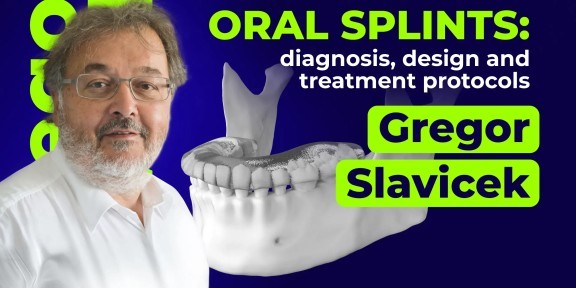
Oral splints: diagnosis, design and treatment protocols
661 $
-25%
available 4 days 00:26:06
Description
This is a course on splint therapy in the concept of Slavicek!
During the course you will learn how to:
– Conduct muscle and occlusion examinations
– Make a functional diagnosis
– Determine indications to a specific type of a splint
– Plan TMD treatment using a splint
– Reposition the mandible and change the VDO.
The course is for prosthodontists, orthodontists and functional dentists.
Course includes next lessons:

Splints - the crutches of dentistry. Intro and basic thoughts
Gregor Slavicek
Historical review - the literature up to 1995
Gregor Slavicek
Convergence of diagnostics, divergence of therapy, indications for intraoral splints
Gregor Slavicek
Concepts and terminology
Gregor SlavicekNeed to consult a training expert?
Lecturers (1 persons)
Founder, CEO and owner of Orehab Minds GmbH, Stuttgart. Honorary member of the Romanian Dental and Maxillo-Facial Prothetic Society, the Italian Association of Gnathology. Visiting Professor of the First Moscow State Medical University. Honorary Professor of the Ukrainian State Medical Academy.
Organizer

OREHAB Minds

Recommended for: Functional dentists, Prosthodontists, Orthodontists.
Total CE credits: 5
Total lecture time: 8 h 11 min
OHI-S receives no commercial support for this program.
The articles:
1. Interdisciplinary approach to temporomandibular disorder: a case report (Part 1: the initial therapy). Gregor Slavicek, Marina Ivanovna Soikher, I. Röthele, R. Selke. 2010
2. Eight Questions on Intraoral Splint Concepts: an Interview with Prof. Rudolf Slavicek. Gregor Slavicek. 2009.
This continuing education activity has been planned and implemented in accordance with the standards of the ADA Continuing Education Recognition Program (ADA CERP).
ADA CERP is a service of the American Dental Association to assist dental professionals in identifying quality providers of continuing dental education. ADA CERP does not approve or endorse individual courses or instructors, nor does it imply acceptance of credit hours by boards of dentistry.
Concerns or complaints about a CE provider may be directed to the provider or to the Commission for Continuing Education Provider Recognition at ADA.org/CERP.

